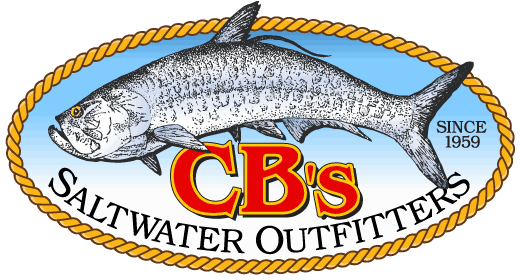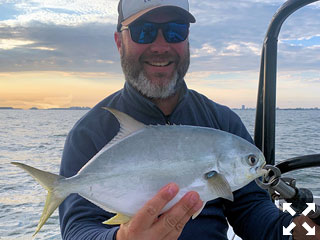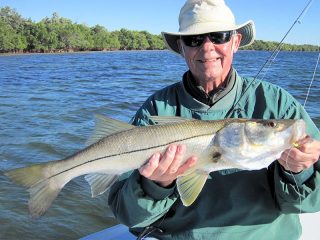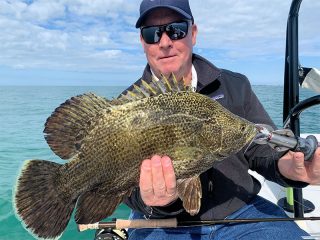You may find reds and big trout concentrated in potholes in January. Action with trout, blues, Spanish mackerel, pompano and more on deep grass flats can be good depending on conditions. There should also be good catch and release snook action in rivers, creeks and canals this month, although fishing docks for snook and other species is also a good option. It may be worth checking the coastal gulf for tripletail, cobia, false albacore (little tunny) and more when it’s warm.
Snook and reds remain closed to harvest south of State Rd 64 in Manatee County on the west coast of Florida, south to the south bank of Gordon Pass in Collier County. Reds and snook are catch and release only in that zone until May 31, 2022. Spotted Seatrout has reopened in that zone with a 3 fish per person, bag limit and a 6 fish boat limit. Trout must be from 15”-19” with one allowed per vessel over 19 inches. Full regulations and details can be viewed at www.myfwc.com
Snook are very temperature sensitive, so I won’t target them if the water temperature dips below 60 degrees. However, fishing lighted docks in the ICW at night with lures and flies can be very good in January. Small white flies, like my Grassett Snook Minnow, Gurglers and shrimp fly patterns will work well for fly anglers. Spin anglers should score with CAL jigs with shad tails or 4” jerk worms, DOA Tiny TerrorEyz and DOA 2-3/4” & 3” Shrimp. Fish peak tidal flows for the best action.
You should also find snook in rivers, creeks and canals this month. Fish deeper water in outside bends to locate snook where you may catch them with CAL jigs and shad tails or jerk worms, DOA Baitbusters or diving/suspending plugs. You may also find reds, juvenile tarpon and even largemouth bass in the same areas depending on salinity.
Fish were turned on ahead of an approaching front. He caught and released a slam, including a 28” snook, 28” redfish, trout and a couple of pompano that were sight fished on top of a bar in 18” of water, all on CAL jigs with a grub tail! Not big numbers of fish but a great day for quality fish and variety.
Fishing deep grass flats of Sarasota Bay is a good choice for action with a variety of species including trout, pompano, blues and Spanish mackerel. Check the coastal gulf for Spanish mackerel, false albacore and tripletail when conditions are good.
Reds should be a good option this month. You’ll find them concentrated in potholes when the tide is low. Fly anglers should score with lightly weighted flies fished on a 10’-12’ leader with a floating fly line. Reds feed on crustaceans this time of the year, so crab and shrimp fly patterns should work well. They may tail on shallow grass flats when the tide is low. You’ll need weedless rigged plastic baits or flies with weed guards to target tailing reds. A CAL shad tail on a weedless hook or a DOA shrimp rigged weedless and fished backwards are a couple of my favorite lures for tailing reds.
You may also find reds around docks, along with snook, sheepshead, flounder and more. Little Sarasota Bay has numerous oyster bars and docks that often hold reds in January. Work CAL jigs slowly along the bottom for the best action. You’re likely to find big trout in many of the same areas that you find reds. The same lures, flies and techniques that are used for reds will also work for big trout.
You’ll also find trout on deep grass flats in January along with blues, Spanish mackerel, pompano, flounder and more. I like to drift and cast ahead of my drift with CAL jigs and a variety of plastic tails and DOA Deadly Combos. Since trout can sometimes hold very tight to a particular spot or area, try to cover as much water as possible to find them. Once you’ve located fish you can shorten your drift or anchor on them.
A GPS can be useful for this type of fishing since the breadcrumb trail will allow you to duplicate your drift. A drift anchor will slow your drift so you can fish it more thoroughly or make it easier for fly anglers to move their fly. My favorite deep grass flats, have a good mix of grass and sand with a strong tidal flow.
Even though there may not be much happening in the coastal gulf this month in the way of sight fishing it may be worth a look when it is warm. Migratory species such as king and Spanish mackerel, cobia and tripletail probably have moved further south, however they could reappear during warm ups. Also look for false albacore (little tunny) when it’s warm since they may move from offshore to inshore depending on where baitfish are located.
January can be one of the toughest months of the year to fish. However if you are able to choose when to fish based on tides and weather, it can be good. Action is usually good as weather fronts approach. Following fronts, fishing may be tough for a couple of days so afternoons may fish better at that time. I’ll let the stage of the tide determine where to look for fish. When the tide is low, look for reds tailing on shallow grass or reds, trout and more in potholes or around docks. Look for reds or big trout cruising on shallow grass flats on sunny afternoons when the tide is high.
Our natural resources are under constant pressure from red tides fueled by agricultural, industrial and residential runoff, toxic spills and discharges, freezes, increasing fishing pressure and habitat loss and degradation, please limit your kill, don’t kill your limit!
Anglers fishing with me, out of CB’s Saltwater Outfitters on Siesta Key, had good action in Sarasota Bay with me recently.You may find reds and big trout concentrated in potholes in January. Action with trout, blues, Spanish mackerel, pompano and more on deep grass flats can be good depending on conditions. There should also be good catch and release snook action in rivers, creeks and canals this month, although fishing docks for snook and other species is also a good option. It may be worth checking the coastal gulf for tripletail, cobia, false albacore (little tunny) and more when it’s warm.
Snook and reds remain closed to harvest south of State Rd 64 in Manatee County on the west coast of Florida, south to the south bank of Gordon Pass in Collier County. Reds and snook are catch and release only in that zone until May 31, 2022. Spotted Seatrout has reopened in that zone with a 3 fish per person, bag limit and a 6 fish boat limit. Trout must be from 15”-19” with one allowed per vessel over 19”. Full regulations and details can be viewed at www.myfwc.com
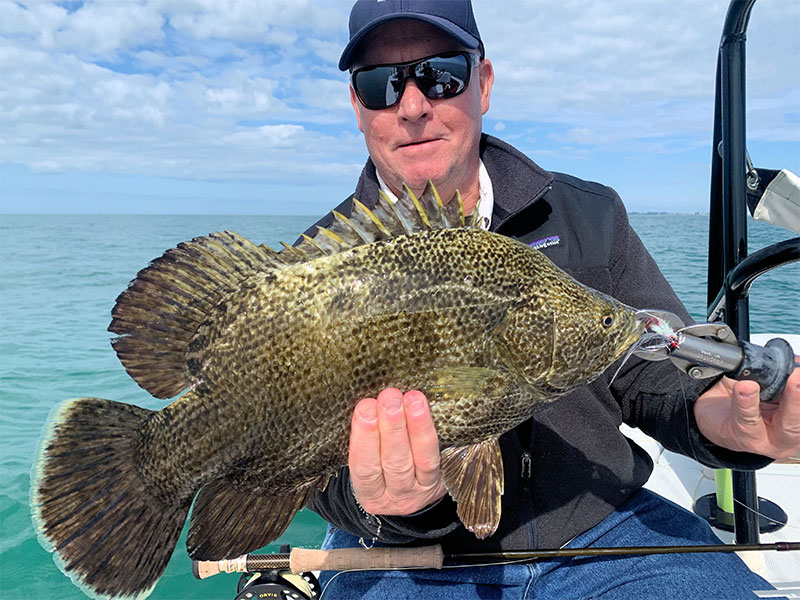
Tripletail may be an option in January depending on conditions. Kirk Grassett, from Middletown, DE, caught and released this one on a fly while fishing with Capt Rick Grassett in a previous January.
Snook are very temperature sensitive, so I won’t target them if the water temperature dips below 60 degrees. However, fishing lighted docks in the ICW at night with lures and flies can be very good in January. Small white flies, like my Grassett Snook Minnow, Gurglers and shrimp fly patterns will work well for fly anglers. Spin anglers should score with CAL jigs with shad tails or 4” jerk worms, DOA Tiny TerrorEyz and DOA 2-3/4” & 3” Shrimp. Fish peak tidal flows for the best action.
You should also find snook in rivers, creeks and canals this month. Fish deeper water in outside bends to locate snook where you may catch them with CAL jigs and shad tails or jerk worms, DOA Baitbusters or diving/suspending plugs. You may also find reds, juvenile tarpon and even largemouth bass in the same areas depending on salinity.
Reds should be a good option this month. You’ll find them concentrated in potholes when the tide is low. Fly anglers should score with lightly weighted flies fished on a 10’-12’ leader with a floating fly line. Reds feed on crustaceans this time of the year, so crab and shrimp fly patterns should work well. They may tail on shallow grass flats when the tide is low. You’ll need weedless rigged plastic baits or flies with weed guards to target tailing reds. A CAL shad tail on a weedless hook or a DOA shrimp rigged weedless and fished backwards are a couple of my favorite lures for tailing reds.
You may also find reds around docks, along with snook, sheepshead, flounder and more. Little Sarasota Bay has numerous oyster bars and docks that often hold reds in January. Work CAL jigs slowly along the bottom for the best action. You’re likely to find big trout in many of the same areas that you find reds. The same lures, flies and techniques that are used for reds will also work for big trout.
You’ll also find trout on deep grass flats in January along with blues, Spanish mackerel, pompano, flounder and more. I like to drift and cast ahead of my drift with CAL jigs and a variety of plastic tails and DOA Deadly Combos. Since trout can sometimes hold very tight to a particular spot or area, try to cover as much water as possible to find them. Once you’ve located fish you can shorten your drift or anchor on them.
A GPS can be useful for this type of fishing since the breadcrumb trail will allow you to duplicate your drift. A drift anchor will slow your drift so you can fish it more thoroughly or make it easier for fly anglers to move their fly. My favorite deep grass flats, have a good mix of grass and sand with a strong tidal flow.
Even though there may not be much happening in the coastal gulf this month in the way of sight fishing it may be worth a look when it is warm. Migratory species such as king and Spanish mackerel, cobia and tripletail probably have moved further south, however they could reappear during warm ups. Also look for false albacore (little tunny) when it’s warm since they may move from offshore to inshore depending on where baitfish are located.
January can be one of the toughest months of the year to fish. However if you are able to choose when to fish based on tides and weather, it can be good. Action is usually good as weather fronts approach. Following fronts, fishing may be tough for a couple of days so afternoons may fish better at that time. I’ll let the stage of the tide determine where to look for fish. When the tide is low, look for reds tailing on shallow grass or reds, trout and more in potholes or around docks. Look for reds or big trout cruising on shallow grass flats on sunny afternoons when the tide is high.
Our natural resources are under constant pressure from red tides fueled by agricultural, industrial and residential runoff, toxic spills and discharges, freezes, increasing fishing pressure and habitat loss and degradation, please limit your kill, don’t kill your limit!
